This article is part of our body language guide. Click here for more.
What is the one body part that you should always pay attention to when analyzing body language? Some might be surprised, but my answer is always the feet.
Some say the eyes are the window to the soul. I say feet are a close second!
Feet show hidden intentions.
I’ve found there are 4 kinds of foot body language.
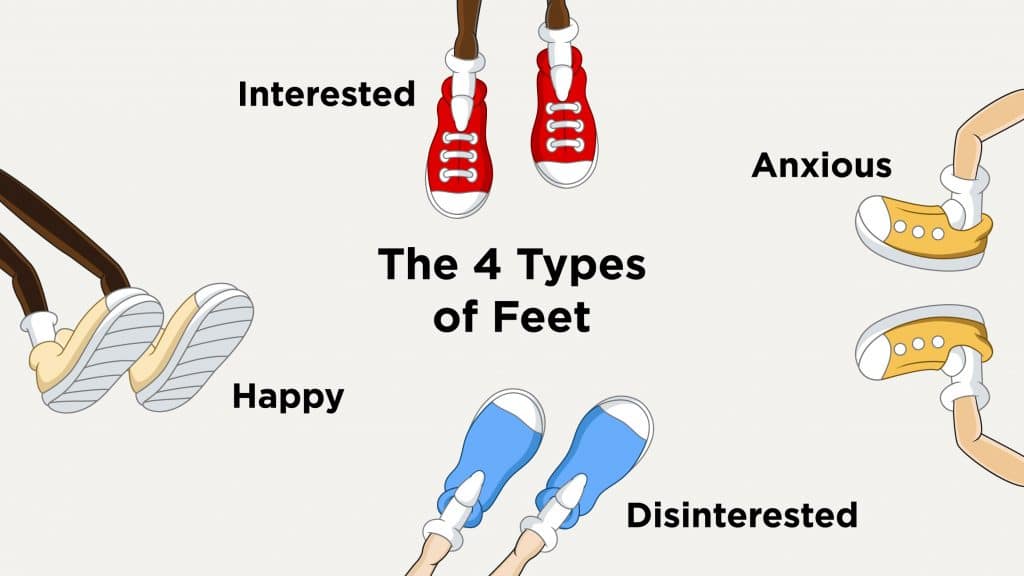
- Interested Feet show desire, attraction, or an interest in being around you.
- Disinterested Feet are the opposite: they want to go away!
- Happy Feet indicate happiness, excitement, or anticipation.
- Anxious Feet cues show up when someone is nervous or under stress.
In this article, we’re going 6-feet under to analyze 18 body language cues given by the feet.

Can You Read Body Language?
How good are your body language skills? Take our free body language quiz to find out!
Interested Feet show desire, attraction, or an interest in being around you. Can you tell which of the following 4 images is likely a sign of interest?
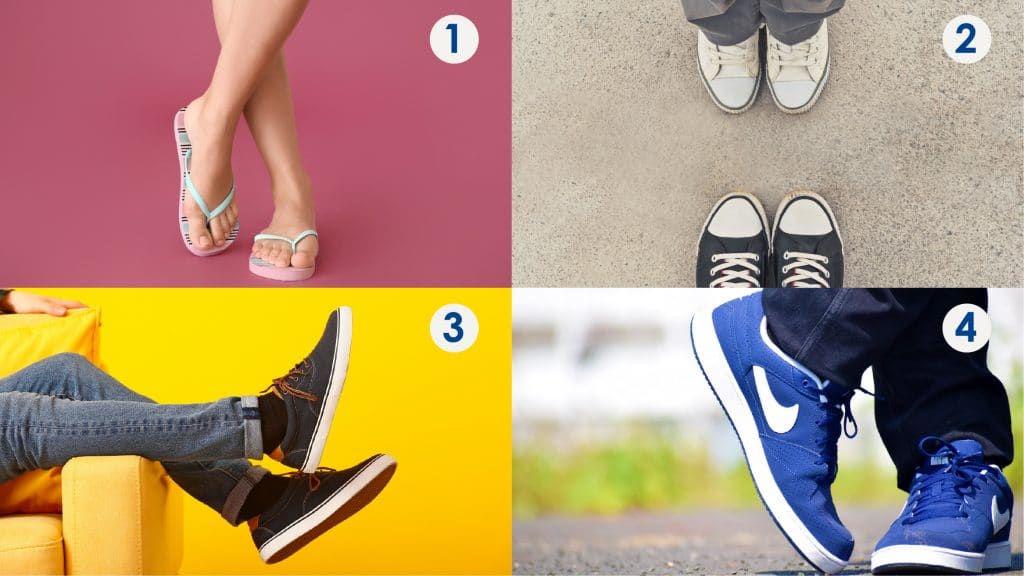
Click to reveal answer
Number 2! This is the feet-pointing cue.
Feet Pointing Cue
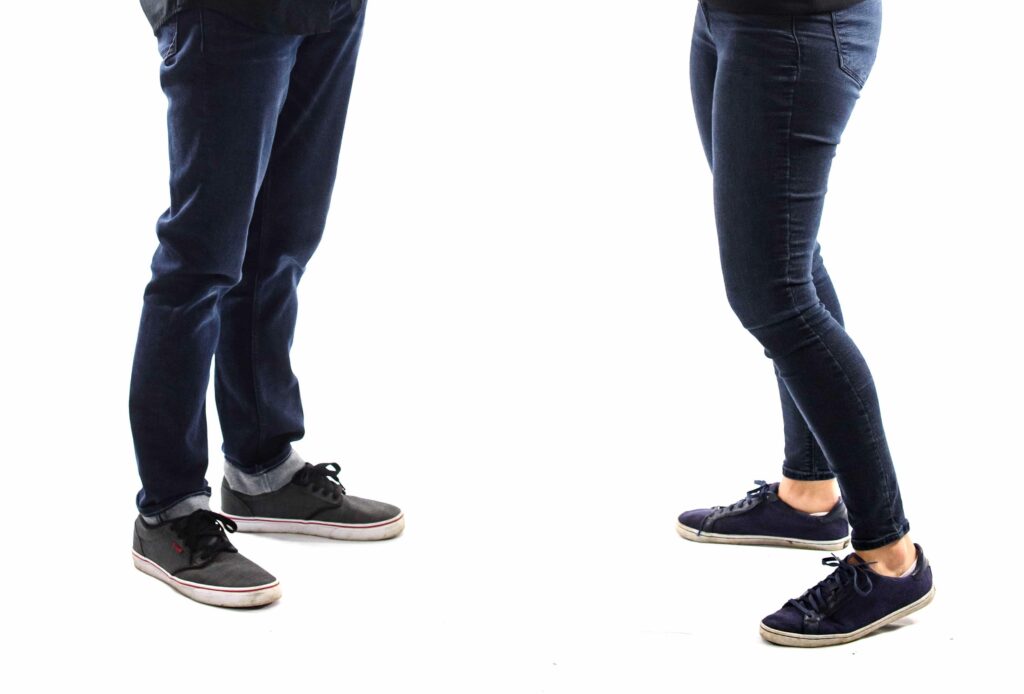
One of the things I always look out for is whether the feet are pointing toward me or away. This is a great way to spot hidden intentions!
What it Means: If feet are pointing toward someone, it might mean the pointer is attracted or interested in them. In large group settings, the most charismatic person will usually have the most feet pointing toward them.
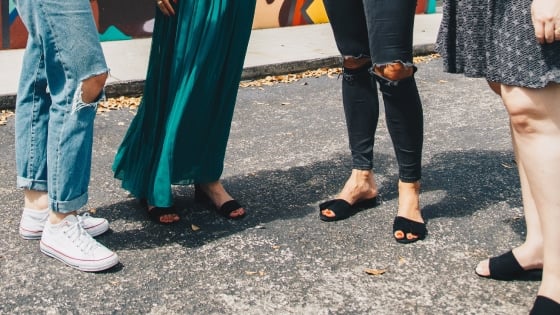
It also helps me to think of the feet as an “interest radar.”
To find out a person’s intentions, look at the direction of their feet.
How to Use it: When you’re interested in someone and want them to know, make sure your feet are pointing at them. In general, your feet should be pointed most of the time toward people like your date, business clients, and acquaintances.
The V
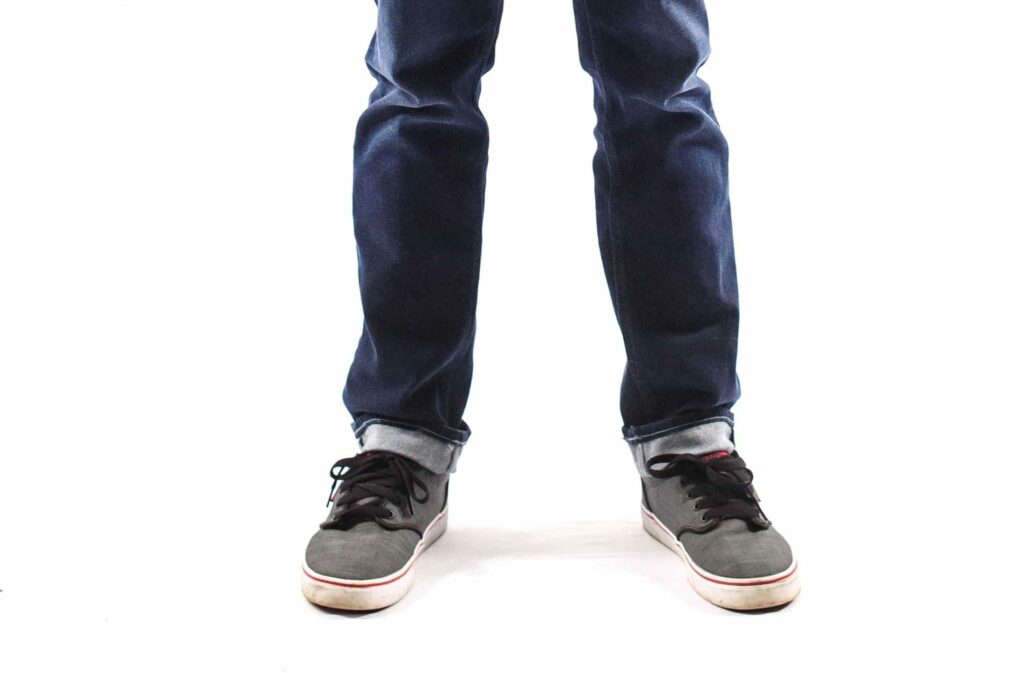
Just the other day, I met an acquaintance on my daily stroll at the park. She always walked like she had rockets attached to her feet, so I didn’t know if she genuinely wanted to chat or was in a rush.
So I looked at her feet.
Her feet were in the V-shape. This was my signal to continue our conversation—we even made plans to have dinner later! Score!
All because of the power of the V.
What it Means: The V is another sign of mutual interest. It’s like an open embrace of the feet, welcoming anyone inside of its V-shape.
In a conversation, the V-shape will look like this:
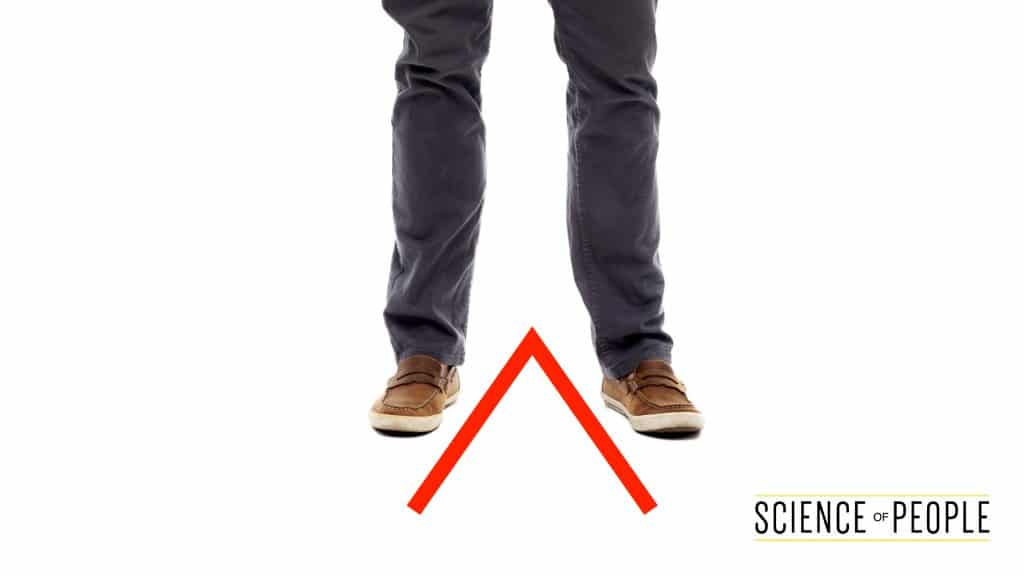
If the person is NOT interested in you, they may angle their feet away like this:
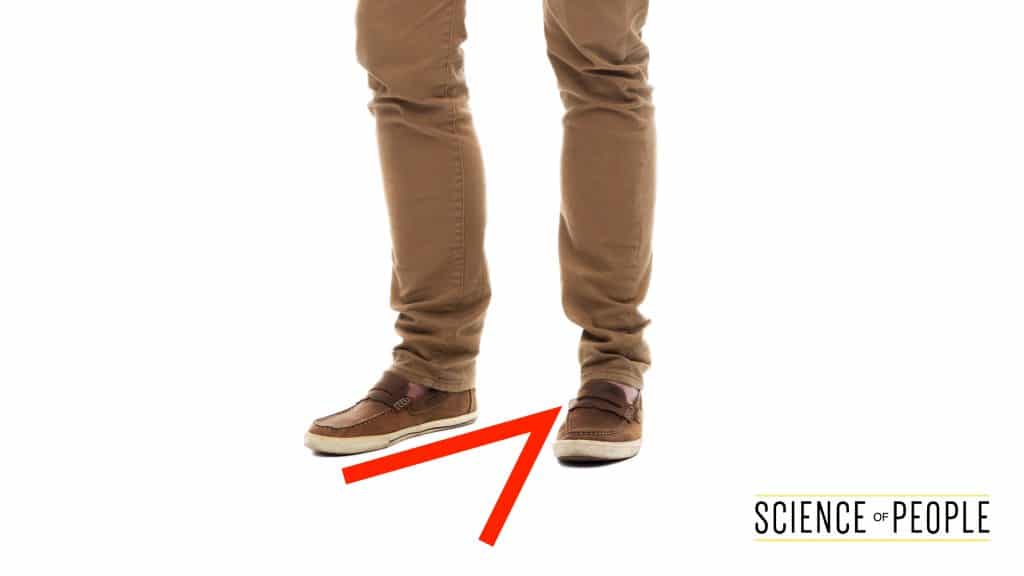
How to Use it: When approaching someone, pay close attention to the angle of their feet. If they open up to embrace you in their V-shape, you’ve got green lights. If you’re outside of the V-shape, they may not be interested in talking with you.
Tony the Tiger
Okay, so I must confess 2 things to you. Number 1; I LOVE cereal. And number 2—
Tony the Tiger is my cereal mascot crush.
And I will tell you why he should be yours, too.
Tony the Tiger also does what we call ‘fronting’. This is when you aim your head, torso and toes towards the person who is looking at you. A way to remember fronting is by the rule of 3 T’s:
Top
Torso
Toes
When we front the people we’re engaged in conversation with, we are nonverbally showing a sign of respect. Not only does Tony have his shoulders nice and open and facing forward but his feet are facing outward, as if he were saying, “I am including everyone who is looking at me.”
His toes are even inclusive. So if you are going down the cereal aisle and you look at the cereal box, you briefly feel like he’s paying attention to you, and this is exactly what kids like to see.
If you want to show interest and confidence, remember my favorite cereal crush.
Foot Forward
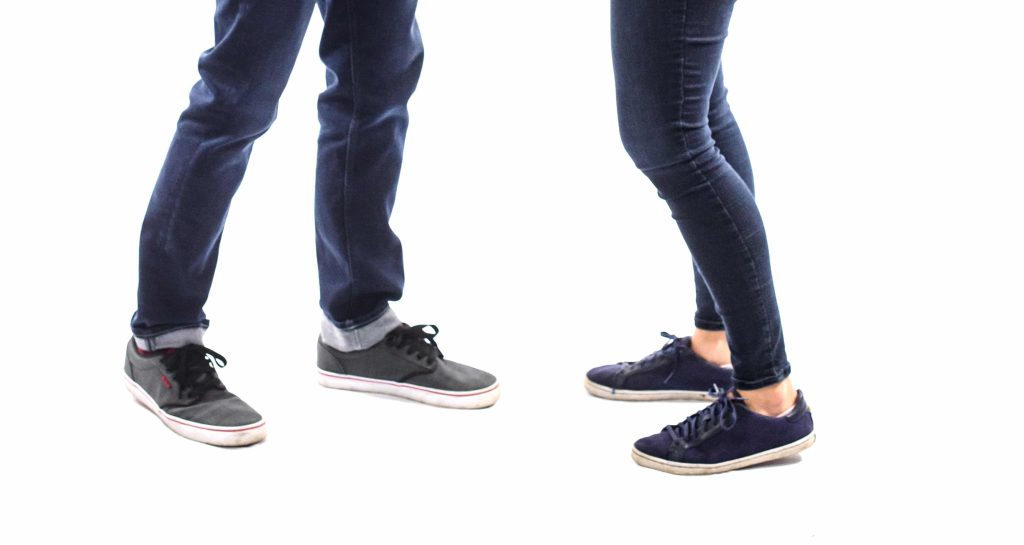
Have you ever heard the phrase “put your best foot forward”? This isn’t just a fancy quote—putting your foot forward also works in social interactions!
What it Means: A foot forward usually signals great interest or attraction. Putting one foot forward shortens the distance. This is a nonverbal way of saying, “I want to be closer to you.”
Similarly, a step back may mean someone is disinterested or disgusted.
How to Use it: The next time you want to show interest, take a small step forward. But be careful not to invade someone’s personal space!
Dangling Shoe
Let’s say you’re on a date with a woman. You sneak a look underneath the table and see her foot dangling a shoe.
Thoughts rush into your head.
Excitement. Playfulness. Flirtation.
This one’s a big giveaway—the dangling shoe of love.
What it Means: Usually done by women, dangling a shoe exposes her heel and is only done when she feels very comfortable and shows high interest.
It couldn’t be any more obvious if it were a giant flashing red arrow above her head.
The dangling shoe is a nonverbal way to say, “notice me.”
Women do this because the movement of the dangling shoe invites attention1https://www.amazon.com/What-Every-Body-Saying-Speed-Reading/dp/0061438294. And if her feet are close to yours when she’s dangling her shoe, even better! This means she’s very comfortable.
It can also be disguised as a more subtle foot-rocking gesture, especially when women are in large public spaces or don’t want to remove their shoe.
How to Use it: If you see this one on a date, you’re doing great! You can also test the waters by moving your foot closer to hers. Does she bring her foot back, denying your advances? Does she keep it there or bring it closer?
Footsies
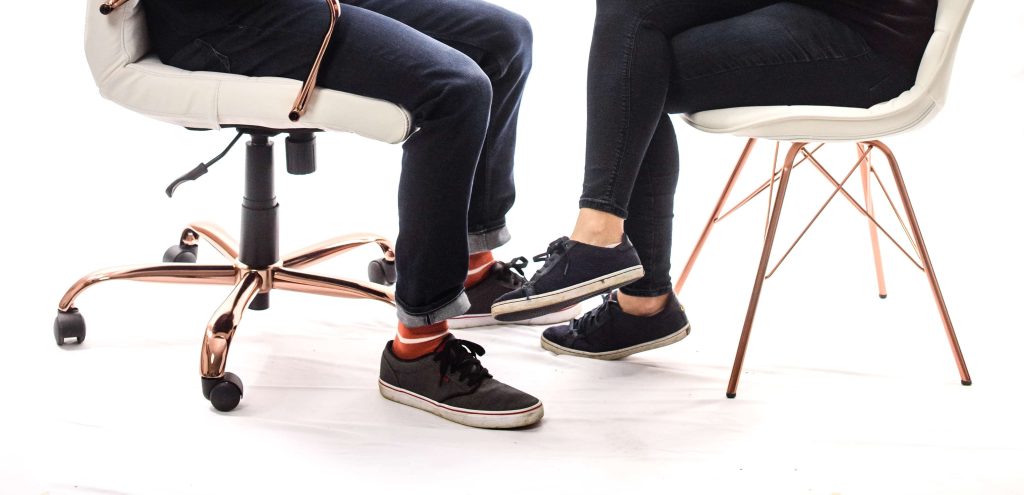
Crank it up to 11 and you’ve got the ultimate interest cue: footsies.
What it Means: If a girl or guy initiates a game of footsies with you, then it’s boom-chicka wah wah a good sign for you!
Here’s why we do it: according to a 2012 study2https://www.tandfonline.com/doi/abs/10.1080/01463373.2012.704568 of 164 married people, couples reportedly played footsies in order to create their own private sanctuaries.
Couples often play footsies in public to create a “private world” of intimacy between them.
It’s like saying, “I know what we’re doing, but nobody else does!”
Touching each others’ feet also activates a sensor along the parietal lobe of the brain, very close to where our genitals also register3https://www.amazon.com/Dictionary-Body-Language-Field-Behavior-ebook/dp/B075JDX981.
And if you notice an accidental “brushing” of their foot against yours and wonder what it means… it’s probably best to listen to author Traci Brown4https://www.amazon.com/Persuasion-Point-Language-Speech-Influence/dp/0692305041/: “There are few accidents in body language. This is a way to reach out and touch you.”
How to Use it: Want to ramp up the attraction, but you’re in a public space? Start a game of footsie and see how the other reacts!
Watch our video below to learn how to read people and decode 7 body language cues:
Want more ways to find out if they’re interested in you?
Male Body Language of Attraction
Disinterested feet are the opposite of interested feet: they want to go away!
Feet Pointing Away
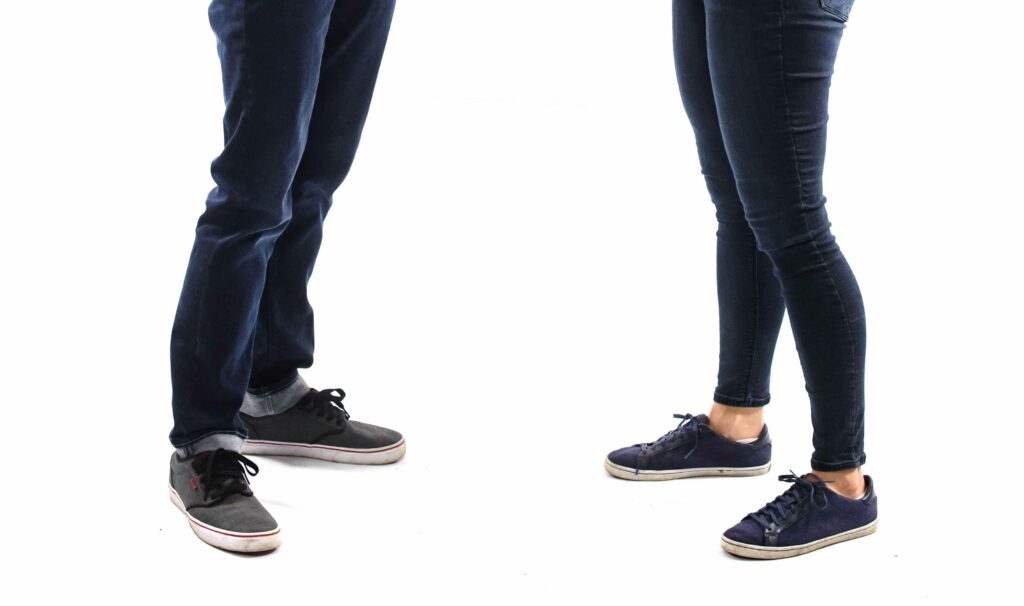
If you’ve ever been in a dull conversation, look down. Chances are, your feet are pointed toward the nearest exit, or at least in another direction, looking for an escape route.
We’ve all been there, and you’re not alone.
What it Means: While feet pointing away can signal disinterest, it doesn’t ONLY signal dislike or disinterest. Sometimes people will just turn away during conversation because they realize they’re late, and they’re in a hurry to pick up their morning Starbucks.
Studies of courtroom behavior show when jurors don’t like a witness, their upper bodies turn to the witness out of politeness, but look down below and their feet will be pointing away1https://www.amazon.com/What-Every-Body-Saying-Speed-Reading/dp/0061438294.
Navarro also found that people who act confident in airport customs, making affirmative statements like “I have nothing to declare, officer,” but who have their feet turned away from the customs officer are more likely to be concealing something they should have declared.
How to Use it: If you want to make it obvious you aren’t interested, point your toes away AND turn your body. Only the most oblivious will be unaware of the meaning of this stance. So if you’re in a rush and you’re caught in an unwanted conversation, you’ll have a better chance at finding an exit (and having time to grab your morning Starbucks, too).
Feet Crossed
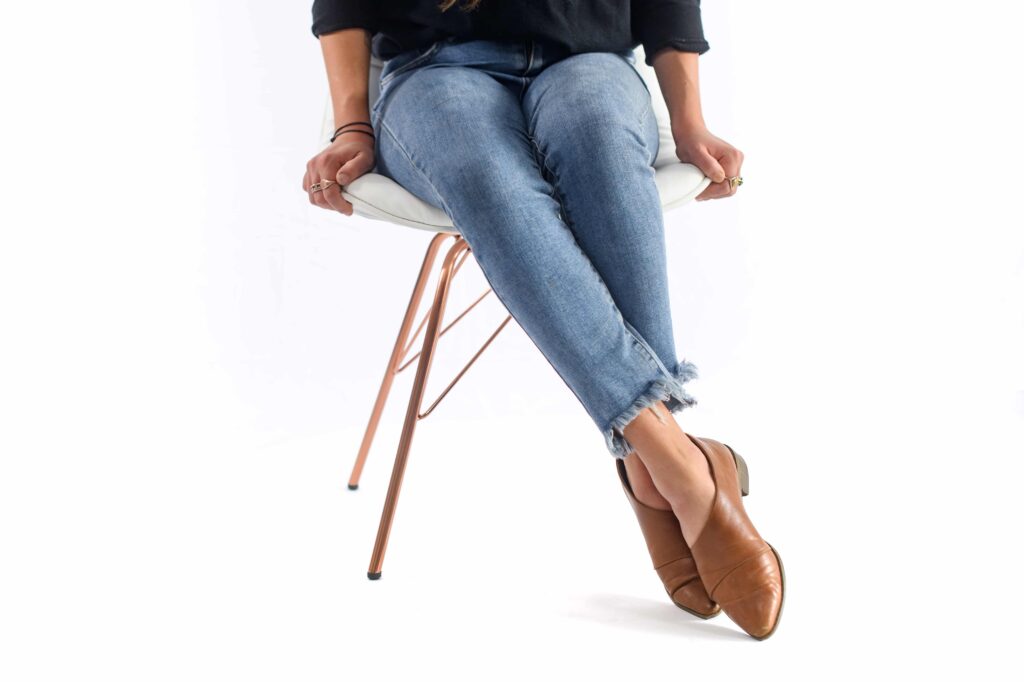
Most of us already know the meaning of crossed arms. But what about crossed feet?
What it Means: When a person suddenly crosses their feet, they might be feeling uncomfortable or defensive. Even still, the feet may normally point towards the person they are the most comfortable with or attracted to, so keep an eye on the direction of the feet even when they’re crossed.
Crossing our feet together also feels good since we can relax one foot on top of the other. This can also signal relaxation, especially if the feet are outstretched.
Dominant Feet
I never do this feet body language cue. Not because it’s uncomfortable or I don’t want to sometimes, but because of what it signals. The cue is… putting your feet on the table.
What it Means: Feet on the table is ultra “boss” mode, feeling good, in command, in control, and no regard for politeness or formality. Putting your feet up is a HUGE power move and you might see powerful men doing this, especially if he’s the boss or the leader of a group of teenage kids.
How to Use it: Put your feet up when you’re feeling dominant and want others to know that, too. But beware—put your feet on another person’s table and you may be invading their territory!
We do all kinds of feet movements, but anxiety leaks out like a melted wax from a burning candle. To remember anxious feet, remember closeness. The closer the feet are, generally, the more anxiety a person may be feeling.
Let’s start with…
The Shuffle
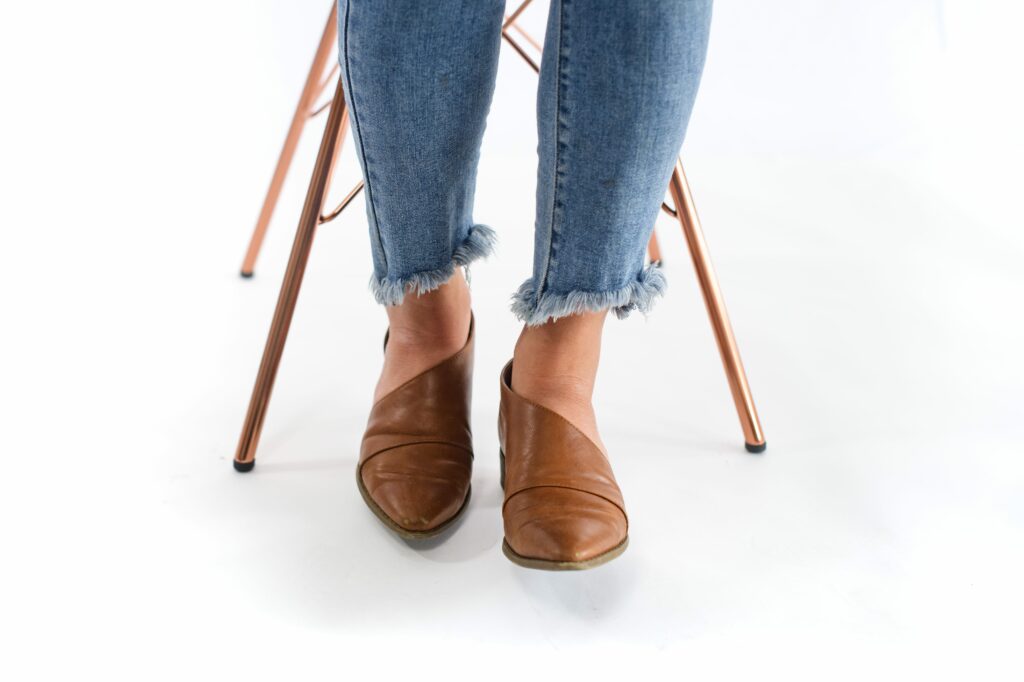
Imagine you’re engrossed in a deep conversation with someone you’ve just met. You’re laughing and having a great time, but you notice the other person’s feet doing the shuffle.
What could this mean?
- a) They lack confidence
- b) They might be hiding the truth
- c) Both a and b
Click to reveal answer
The correct answer: c
What it Means: Shuffling feet can signal a lack of confidence. We shuffle our feet to get a stronger feeling of “groundedness” when we lose confidence and to provide tactile reassurance.
But when confronting someone who may be lying, shuffling feet might be an indicator they may be hiding something.
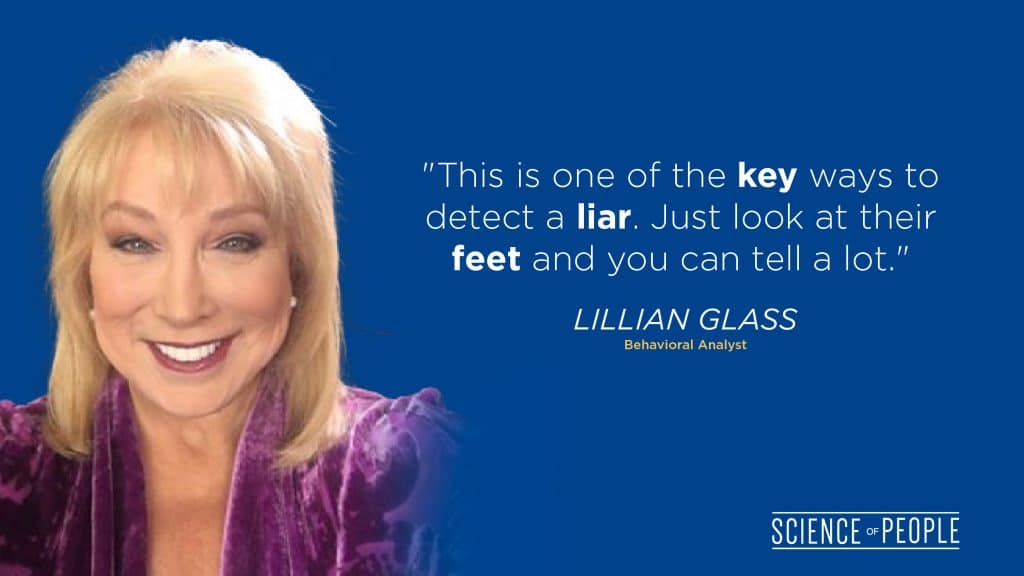
Want to find out how to spot a liar? Here’s our ultimate guide to detect deception.
How to Avoid it: Sometimes shuffling is a bad habit. Kick this habit by chewing gum instead.
The Kick
The foot kick happens usually when seated, almost as if kicking an imaginary ball in the air over and over again.
What it Means: There are 3 stages to kicking:
- Breeze, which is like a gust of wind blowing your foot
- Jiggle, where the foot goes back and forth rhythmically
- Kick, where the foot goes into full-on kicking motion
As the stages go from Breeze, to Jiggle, to Kick, the anxiety also increases.
In an interview with Academy Awards nominee Kim Basinger, you can observe some strange body language behavior from her. She was obviously nervous and at the second stage of kicking, jiggling her hands and feet throughout the interview.
But when the interviewer asked her about some financial difficulties in a questionable investment she and her husband made, Basinger’s foot went from simply jiggling… to stage 3 kicking (timestamp 7:55):
Did you see the foot kick? The kick happens when people hear something negative, or they don’t want to answer a question but are forced to.
The kicker signals high discomfort and a subconscious effort to “kick away” something they don’t like.3
Anytime the foot goes from jiggling to a faster/violent kick, it’s a very good indicator that they are not happy about something.
But what if their foot goes from a constant kick to suddenly stopping? This may signal the “freeze” mode of their limbic system activating. It could mean stress, emotional change, or a feeling of threat.
How to Use it: Observe what question triggers the foot kick in the other person. If you want to keep rapport, ease off on the questioning or offer emotional support.
The foot kick is one of the cues to look for during a negotiation.
Looking at Shoes

If you’ve ever been a recovering awkward person like me, I’m sure you can relate to looking down at your shoes more than at the other person in front of you.
What it Means: Super shy people might have a habit of looking down and avoiding eye contact. They could be feeling a bit:
- Anxious
- Unconfident
- Submissive
…or a combination of the above.
Submissive employees will often avoid extra-long eye contact with their boss, while their dominant bosses will hold more eye gaze.
In some cultures such as many Asian, Latin American, and African cultures, it is completely normal to look away to avoid being disrespectful.
Interestingly, you can see this same phenomenon in silverback gorillas. It’s known that if you ever find yourself in a hairy situation facing a silverback, you must avoid eye contact or the gorilla might… *ahem* go bananas.
Let’s watch this interesting clip on how to react if you ever end up facing a giant gorilla:
How to Use it: Believe it or not, looking down isn’t all negative. If the other person is being aggressive, you can imagine they’re a silverback gorilla and look down, making yourself smaller in the process.
This may help you look more submissive, possibly avoiding confrontation, as opposed to making yourself more aggressive and provoking a fight.
Want more aggression cues? Head on over to our guide on spotting aggression.
Ankle Lock
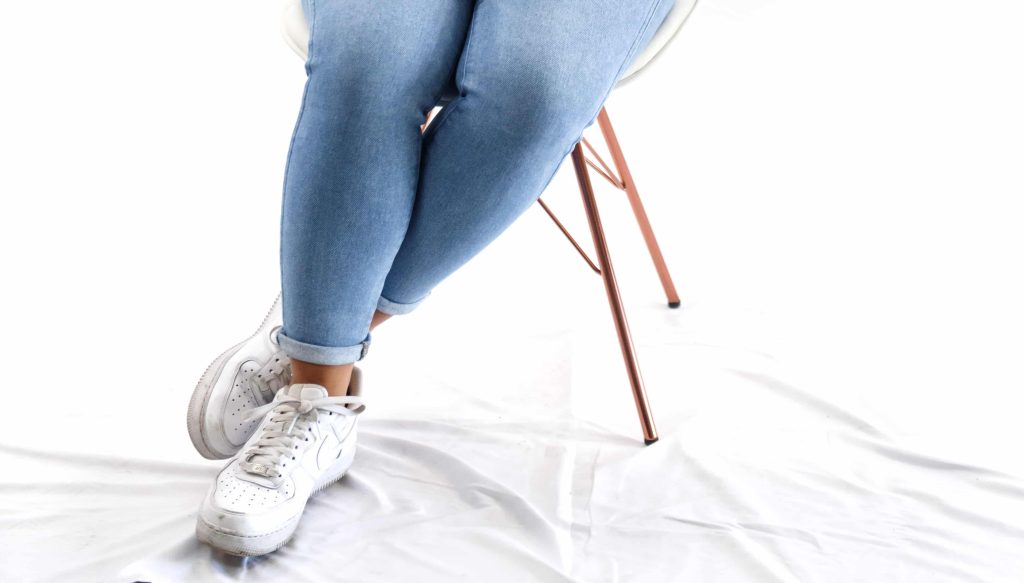
The ankle lock is when the feet are crossed and pulled back behind, usually done when sitting. This effectively “locks” the person in place, securing them in place to the seat.
It can also be a sweet wrestling move.
What it Means: Since the feet go underneath the chair, the ankle lock is a natural retreat and hiding behavior. It may be a sign of anxiety, especially if the ankles are held tightly together.
When people are confronted with the truth, you may notice their feet go in the ankle lock position as they feel less confident or may be hiding a valuable piece of information. Researchers Niernberg and Calero found5https://www.amazon.com/Definitive-Book-Body-Language-Expressions/dp/0553804723 that by using questioning techniques, they could encourage people to unlock their ankles and reveal the information they were hiding.
Fun Fact: An overwhelming majority of people lock their ankles when at the dentist.
According to the Peases’ study of 319 dental patients, they found that 89% of patients locked their ankles as soon as they sat in the chair to get some dental work done2. On the other hand, patients who were only having a checkup locked their ankles only 68% of the time, while a whopping 98% locked when they received an injection.
They also noted that over decades of interviewing and selling to people, when people locked their ankles this cue is similar to a mental “lip biting.” In other words, the person is hesitant and isn’t ready to buy. If you see this cue in sales, spend more time warming them up or move on to another potential buyer.
Take the ankle lock one step further, and you may see people locking their feet around the legs of a chair. This is a high-stress behavior, and the other person is basically restraining themself or bracing for impact.
Feet Edging
Have you ever lifted your feet inward, revealing the bottoms of your shoes?
This is known as feet edging.
What it Means: When feet edging, you’re literally “losing your ground”, not to mention this is a terrible way to walk.
Feet edging is done when we’re already feeling “ungrounded” or nervous. The more nervous we feel, the more we shift our weight to the edges of our feet. You might have even done this often (or still do) as a student, especially when waiting for test results. Little kids also do this when you ask them a hard question.
How to Use it: Are you a manager or boss? When giving interviews, you might spot this cue when asking an important question. It could mean uncertainty, or they might be fibbing about their answer.
Are you in a relationship? Troubled spouses may do this when having to confess something terrible they’ve done… like leaving their socks around the house (I’m looking at you, Scott!).
Pigeon Toes
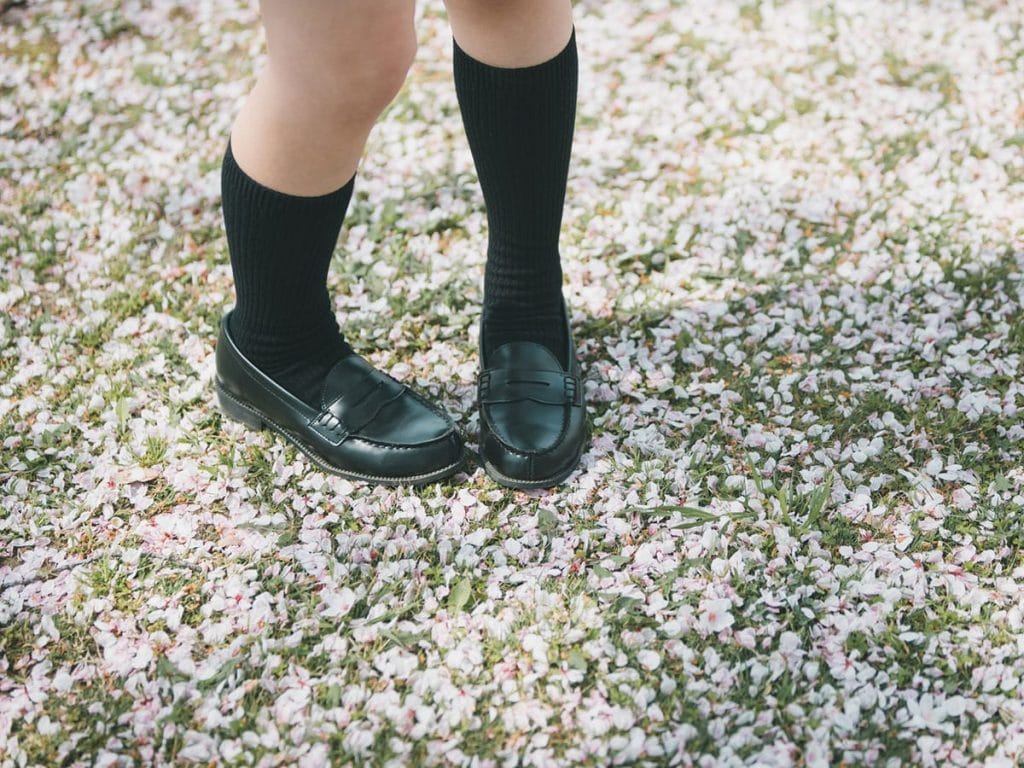
Believe it or not, pigeons have toes, and humans sometimes resemble pigeon toes when we turn our feet inward. Hence the name: pigeon toes.
This can be common–as some people’s normal stance–but a sudden shift of toes pointing inward can also have deeper meanings.
What it Means: Some cultures, such as the Japanese, consider6https://www.japantimes.co.jp/news/2006/09/19/reference/o-kyaku/ this a “graceful, attractive gait.” Japanese women are even praised and adored by others for having this pigeon-like stance.
Otherwise, a sudden movement inward, as the toes move closer together, can signal insecurity, anxiety, or shyness. Since turning feet inward is a natural closing gesture, it also indicates a closing down of the V-shape and a desire to end conversation.
How to Use it: If you see a sudden shift to pigeon toes, try moving to the person’s side. This encourages them to change their stance, possibly moving their feet in a more open position.
I remember one sales pitch I had to give in front of a large Fortune 500 corporation. This was the make-or-break sales pitch that would decide whether the company would hire me on as their trainer or not.
The pitch went exceedingly well and according to plan. But then it came to price. As I confidently stated my price, I noticed the sales manager furrowing his eyebrows and tensing his mouth.
“I’ll let you know our final decision tomorrow,” he said.
Uh-oh! Was it too high? Was the sales pitch for nothing? I thought it wouldn’t work out.
But then I noticed his feet body language.
His feet were pointing sky high, toes aimed straight at the ceiling!
The next day, I received a phone call and an excited approval from the sales manager. It turns out, while his face said no, his feet couldn’t help but reveal his excitement.
Upward-Pointing Feet

Upward-pointing feet is a gravity-defying cue (and my lifesaver!) when weight shifts to the back of the heel, pointing the toes upward.
What it Means: You know what this cue reminds me of? Little elf shoes.
Elf shoes are ALWAYS pointing up, curled up to demonstrate Christmas cheer. And in the same way, whenever someone’s toes defy gravity and point upward, it could mean they’re in a really good mood.
On a side note, Navarro observed that this cue is rarely seen in people with clinical depression1https://www.amazon.com/What-Every-Body-Saying-Speed-Reading/dp/0061438294. And in my experience, it is really hard to be sad and point your toes sky-high at the same time!
The Rhino Stomp
Shhh… Did you hear that? It’s the rare sound of a foot stomp—common among bold businessmen and cantankerous kids alike.
And, of course, angry rhinos.
What it Means: The foot stomp can mean 3 things:
Anger: You can observe the foot stomp in young kids when they’re forced to do their homework
Stress: You’ll also see the foot stomp in arguments between couples when one spouse loses, or there is no clear outcome.
Happiness: Excited and happy individuals who have an “aha!” moment may also foot stomp.
How to Use it: A stomp is a really powerful cue. Depending on the intensity of your stomp, you can demonstrate your anger or excitement when discussing a powerful message. Most public speakers avoid this cue unless they want to make a power statement, so I’d keep it to a minimum if possible.
Bouncing Feet
We’ve all got that friend or relative who keeps on bouncing their feet no matter what…
- Waiting in line? Bouncing foot.
- Amazing Christmas gift? Bouncing.
- At a funeral? Yep, still bouncing.
What does it mean—and will the bouncing ever end?
What it Means: Bouncers typically shake their feet to release stored energy or tension.
- It can happen when we’re happy or excited, like when hearing about a bargain.
- It can also signal nervousness or anxiety, like when readying for a competition or event.
- Chronic bouncers also do it when bored, concentrating, impatient, or simply out of habit.
- We even bounce our feet when we’re dancing.
People who bounce to the extreme may even have RLS, or restless leg syndrome, which causes them to feel an uncontrollable urge to bounce… even in their sleep!
How to Use it: When facing a bouncer, I found the best method is to just let them bounce. Stopping it will likely only bring forth a bouncing marathon in its place!
But if you’re in an important business deal, bouncing may be a good negotiation cue that signals excitement.
Wiggling Toes
Babies and kids LOVE to wiggle, stretch, and play with their toes.
As we get older, though, we tend to hide them with shoes and formality. However, the meanings are still the same.
What it Means: You may not be able to spot this one easily (especially if someone is wearing shoes), but wiggling toes is usually a sign of happiness and excess energy. It’s called “happy feet” for a reason, as excess energy is spilled out to our feet.
According to Harvard Medical School7https://www.health.harvard.edu/healthbeat/exercises-for-healthy-feet, wiggling toes even has one extra benefit: it can strengthen your toes and decrease the risk of injury. Who knew?
How to Use it: Are you a constant leg shaker or can’t stop bouncing? If you have an important interview or meeting, wiggle those toes instead to secretly release all that extra tension!
And if you want more cues, be sure to check out our ultimate body language book:

Unlock the Secrets of Charisma
Control and leverage the tiny signals you’re sending – from your stance and facial expressions to your word choice and vocal tone – to improve your personal and professional relationships.
One Small Step…
If this is one of the few body language articles you’ve read, congratulations!
You’re one step closer to becoming a Body Language Master!
After feet body language, he next step is to check out our intro to body language, if you haven’t already, or head on over to the leg body language section for some extra “foot” for thought.
And as always…
To your body language success,
Vanessa
Crack The Code on Facial Expressions
The human face is constantly sending signals, and we use it to understand the person’s intentions when we speak to them.
In Decode, we dive deep into these microexpressions to teach you how to instantly pick up on them and understand the meaning behind what is said to you.
Don’t spend another day living in the dark.
Side Note: As much as possible we tried to use academic research or expert opinion for this master body language guide. Occasionally, when we could not find research we include anecdotes that are helpful. As more research comes out on nonverbal behavior we will be sure to add it!
This article is part of our body language guide. Click here for more.
Article sources
- https://www.amazon.com/What-Every-Body-Saying-Speed-Reading/dp/0061438294
- https://www.tandfonline.com/doi/abs/10.1080/01463373.2012.704568
- https://www.amazon.com/Dictionary-Body-Language-Field-Behavior-ebook/dp/B075JDX981
- https://www.amazon.com/Persuasion-Point-Language-Speech-Influence/dp/0692305041/
- https://www.amazon.com/Definitive-Book-Body-Language-Expressions/dp/0553804723
- https://www.japantimes.co.jp/news/2006/09/19/reference/o-kyaku/
- https://www.health.harvard.edu/healthbeat/exercises-for-healthy-feet
8 thoughts on “Feet Behavior – The Untapped Body Language You Should Know”
Comments are closed.
How to Deal with Difficult People at Work
Do you have a difficult boss? Colleague? Client? Learn how to transform your difficult relationship.
I’ll show you my science-based approach to building a strong, productive relationship with even the most difficult people.

Thanks for the shout out!
Thanks for the shout out!
Thanks for the shout out!
Thanks for the shout out!
Thanks Venessa
Thanks Venessa
Thanks Venessa
Thanks Venessa